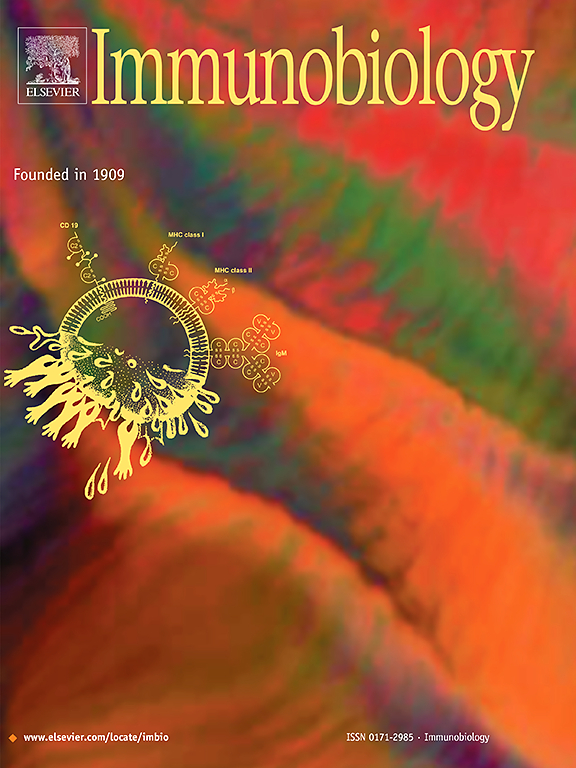APOE modulates ferroptosis to drive macrophage polarization toward the M2 type and enhance PTC migration and invasion
IF 2.3
4区 医学
Q3 IMMUNOLOGY
引用次数: 0
Abstract
Background
Previous studies have found that Apolipoprotein E (APOE) plays a crucial role in invasion and migration of papillary thyroid carcinoma (PTC) cells and enhance M2 macrophage polarization. Ferroptosis has been implicated in development of various tumors and their treatment resistance, and studies have shown that APOE is involved in ferroptosis regulation. However, whether APOE promotes PTC progression through ferroptosis modulation remains unclear. This study aims to investigate the ferroptosis-related mechanisms through which APOE facilitates cell invasion, migration, and macrophage polarization in PTC.
Methods
The expression levels of APOE, Sodium-dependent cystine/glutamate exchanger (xCT), Glutathione Peroxidase 4 (GPX4), Ferritin Heavy Chain 1 (FTH1), and Fe2+ in PTC tissues were detected using immunohistochemistry, Prussian blue staining, and western blot. The effects and mechanisms of APOE on ferroptosis were further examined through a series of experiments, including immunofluorescence, electron microscopy, RT-qPCR, western blot, and colorimetric assays. Additionally, In vivo experiments were conducted to assess the effect of APOE silencing on ferroptosis. The interaction between ferroptosis and macrophages in regulating PTC cell invasion and migration was validated using assays.co-culture systems, wound healing assays, and Transwell migration assays.
Results
In PTC tissues, Fe2+ accumulation was lower than in adjacent normal tissues, while the expression of APOE, xCT, GPX4, and FTH1 was significantly higher compared to adjacent normal tissues. Functional assays demonstrated that APOE inhibited ferroptosis in PTC cells, potentially by regulating ferroptosis through the PI3K/AKT1 pathway and modulating Fe2+ accumulation. Furthermore, APOE enhanced the invasion and migration abilities of PTC cells by promoting M2 macrophage polarization via ferroptosis inhibition.
Conclusion
This study reveals that APOE regulates ferroptosis through the PI3K/AKT1 pathway, thereby driving macrophage polarization toward the M2 phenotype, which in turn promotes the invasion and migration of PTC.
APOE调节铁凋亡,驱动巨噬细胞向M2型极化,增强PTC的迁移和侵袭
既往研究发现载脂蛋白E (APOE)在甲状腺乳头状癌(PTC)细胞的侵袭和迁移过程中起重要作用,并增强M2巨噬细胞极化。铁下垂与多种肿瘤的发展及其治疗耐药性有关,研究表明APOE参与了铁下垂的调控。然而,APOE是否通过铁下垂调节促进PTC进展仍不清楚。本研究旨在探讨APOE在PTC中促进细胞侵袭、迁移和巨噬细胞极化的机制。方法采用免疫组化、普鲁士蓝染色、western blot检测PTC组织中APOE、钠依赖性胱氨酸/谷氨酸交换物(xCT)、谷胱甘肽过氧化物酶4 (GPX4)、铁蛋白重链1 (FTH1)、Fe2+的表达水平。通过免疫荧光、电镜、RT-qPCR、western blot、比色等一系列实验进一步探讨APOE对铁下垂的作用及其机制。此外,我们还进行了体内实验来评估APOE沉默对铁下垂的影响。通过实验验证了铁下垂和巨噬细胞在调节PTC细胞侵袭和迁移中的相互作用。共培养系统,伤口愈合试验和Transwell迁移试验。结果PTC组织中Fe2+的积累低于邻近正常组织,而APOE、xCT、GPX4和FTH1的表达明显高于邻近正常组织。功能分析表明,APOE可能通过PI3K/AKT1途径调节铁凋亡并调节Fe2+积累,从而抑制PTC细胞的铁凋亡。此外,APOE通过抑制铁凋亡促进M2巨噬细胞极化,从而增强PTC细胞的侵袭和迁移能力。结论APOE通过PI3K/AKT1通路调控铁凋亡,从而驱动巨噬细胞向M2表型极化,进而促进PTC的侵袭和迁移。
本文章由计算机程序翻译,如有差异,请以英文原文为准。
求助全文
约1分钟内获得全文
求助全文
来源期刊

Immunobiology
医学-免疫学
CiteScore
5.00
自引率
3.60%
发文量
108
审稿时长
55 days
期刊介绍:
Immunobiology is a peer-reviewed journal that publishes highly innovative research approaches for a wide range of immunological subjects, including
• Innate Immunity,
• Adaptive Immunity,
• Complement Biology,
• Macrophage and Dendritic Cell Biology,
• Parasite Immunology,
• Tumour Immunology,
• Clinical Immunology,
• Immunogenetics,
• Immunotherapy and
• Immunopathology of infectious, allergic and autoimmune disease.
 求助内容:
求助内容: 应助结果提醒方式:
应助结果提醒方式:


